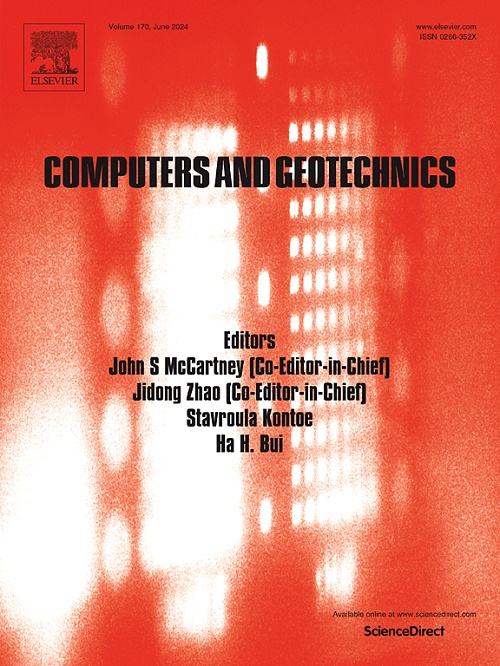基于DEM的填沙结核桩安装过程模拟
IF 5.3
1区 工程技术
Q1 COMPUTER SCIENCE, INTERDISCIPLINARY APPLICATIONS
引用次数: 0
摘要
灌砂结核桩(SFNP)是一种新兴的地基系统,其特点是可提高填海场地的承载力并加速固结沉降。本研究对 SFNP 安装过程中引入的砂砾的填充形态进行了研究,以进一步阐明其形成机制,并探讨其对桩身行为的影响。研究采用离散元素法(DEM),结合高斯分布叠加法(SGDs)实现连续分级,并拟合实际粒径分布(PSD)曲线。该数值模型用于研究结节宽度、结节间距和砾石粒径对 SFNP 地基充填效果的影响。根据观察到的砾石充填模式,充填砾石可分为两个区域:源区和充填区。相邻结核段之间的砾石被桩周围的土侵入,使填充形态接近于倒锥形。结果表明,增加节理段宽度和/或减小节理间距可有效扩大充填区,减少桩周围土壤的侵入。这可能伴随着土壤挤压效应,虽然会增加行车阻力,但最终可以改善桩周围的土壤。虽然增大碎石粒径可以有效增大充填区,但并不能有效防止桩周围土体的侵入。这些发现可为 SFNP 地基在工程实践中的应用提供实际指导。本文章由计算机程序翻译,如有差异,请以英文原文为准。
Simulation of Sand-Filled Nodular Pile (SFNP) installation process using DEM
The sand-filled nodular pile (SFNP) is an emerging foundation system that features improved bearing capacity in reclamation sites and accelerates consolidation settlement. This study investigates the filling morphology of the gravel introduced by SFNP installation to further elucidate its formation mechanism and explore its effect on the pile behaviors. The discrete element method (DEM) is employed, incorporating the superposition of gaussian distributions (SGDs) method to achieve continuous gradation and fit the actual particle size distribution (PSD) curve. The numerical model is used to investigate the effect of nodular width, nodular spacing and gravel size on the filling effect of the SFNP foundation. According to the observed gravel filling pattern, the filling gravel can be divided into two zones: source zone and filling zone. The gravel between adjacent nodular segments is invaded by the pile-surrounding soil, making the filling morphology close to an inverted cone shape. The results indicate that increasing the nodular segment width and/or reducing the nodular spacing can effectively expand the filling zone and reduce the invasion of soil around the pile. This may be accompanied by soil squeezing effect, which may increase the driving resistance but can eventually improve the soil around the pile. Although increasing the gravel size can effectively increase the filling zone, it is not effective in preventing the invasion of pile-surrounding soil. These findings can provide practical guidance for the application of the SFNP foundation in engineering practice.
求助全文
通过发布文献求助,成功后即可免费获取论文全文。
去求助
来源期刊

Computers and Geotechnics
地学-地球科学综合
CiteScore
9.10
自引率
15.10%
发文量
438
审稿时长
45 days
期刊介绍:
The use of computers is firmly established in geotechnical engineering and continues to grow rapidly in both engineering practice and academe. The development of advanced numerical techniques and constitutive modeling, in conjunction with rapid developments in computer hardware, enables problems to be tackled that were unthinkable even a few years ago. Computers and Geotechnics provides an up-to-date reference for engineers and researchers engaged in computer aided analysis and research in geotechnical engineering. The journal is intended for an expeditious dissemination of advanced computer applications across a broad range of geotechnical topics. Contributions on advances in numerical algorithms, computer implementation of new constitutive models and probabilistic methods are especially encouraged.
 求助内容:
求助内容: 应助结果提醒方式:
应助结果提醒方式:


